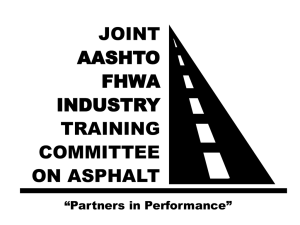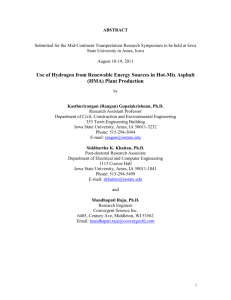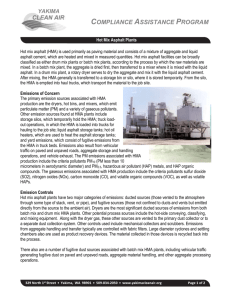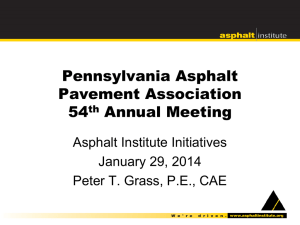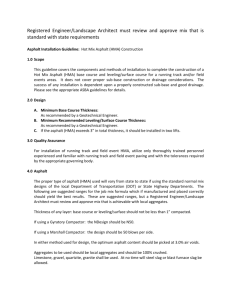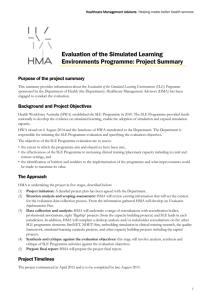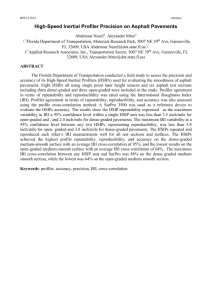Dense-Graded
advertisement
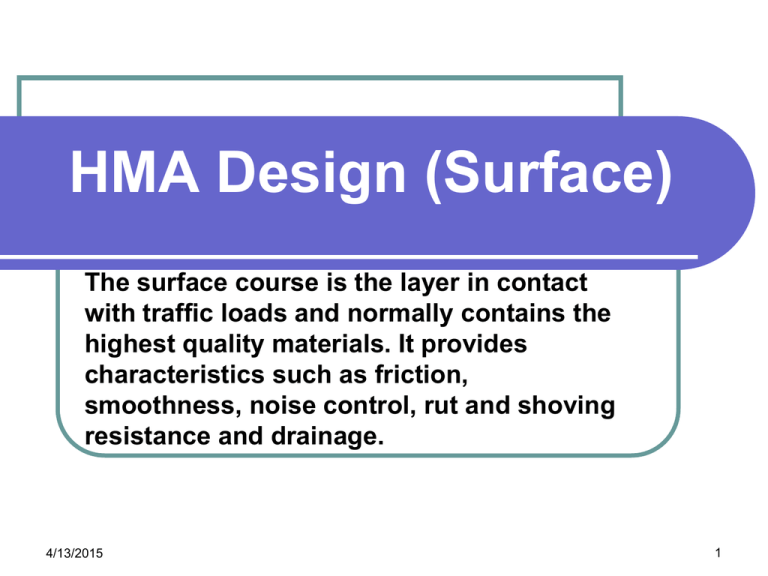
HMA Design (Surface) The surface course is the layer in contact with traffic loads and normally contains the highest quality materials. It provides characteristics such as friction, smoothness, noise control, rut and shoving resistance and drainage. 4/13/2015 CEE 320 1 Steve Muench Surface HMA This top structural layer of material is sometimes subdivided into two layers: Wearing Course. This is the layer in direct contact with traffic loads. It is meant to take the brunt of traffic wear and can be removed and replaced as it becomes worn. A properly designed (and funded) preservation program should be able to identify pavement surface distress while it is still confined to the wearing course. This way, the wearing course can be rehabilitated before distress propagates into the underlying intermediate/binder course. Intermediate/Binder Course. This layer provides the bulk of the HMA structure. Its chief purpose is to distribute load. HMA Types The three most common types of HMA pavement are: Dense-graded HMA. Flexible pavement information in this Guide is generally concerned with dense-graded HMA. Dense-graded HMA is a versatile, all-around mix making it the most common and well-understood mix type in the U.S. Stone matrix asphalt (SMA). SMA, although relatively new in the U.S., has been used in Europe as a material for years to support heavy traffic loads and resist studded tire wear. Also known as Gap Graded Open-graded HMA. This includes both open-graded friction course (OGFC) and asphalt treated permeable materials. Open-graded mixes are typically used as wearing courses (OGFC) or underlying drainage layers because of the special advantages offered by their porosity. Dense-Graded HMA Stone Matrix Asphalt (SMA) Open-Graded Mixes 0.45 Power Gradation 0.45 Power Gradation Curve Using 19.0-mm (0.75inch) Maximum Aggregate Size Calculations for a 0.45 Power Gradation Curve Using 19.0-mm (0.75inch) Maximum Aggregate Size 0.45 Power Gradation Curve for Different Maximum Aggregate Sizes Typical Aggregate Gradations and Permeabilities FHWA gradation graph showing representative gradations No.200 ¾-in No.4 Open Graded Dense Graded % Passing 0.45 power curve Gap Graded Restricted Zone Uniform Graded 0.075 mm 4.75 mm Sieve Size 19 mm Hot Mix Asphalt (Dense-Graded) Hot Mix Asphalt (Open-Graded) Hot Mix Asphalt (Gap-Graded) HMA MIX DESIGN Texas Gyratory Compactor (TGC). For dense-graded hot mix asphalt Superpave Gyratory Compactor (SGC). Marshalls Method HMA MIX DESIGN, Performance Concerns Resistance to Permanent Deformation Resistance to Fatigue and Reflective Cracking Resistance to Low Temperature (Thermal) Cracking Durability Resistance to Moisture Damage (Stripping) Workability Skid Resistance Marshall Mix Design Procedure The Marshall mix design method consists of 6 basic steps: Aggregate selection. Asphalt binder selection. Sample preparation (including compaction). Stability determination using the Density and voids calculations. Optimum asphalt binder content selection. Marshall Mix Design Procedure The Marshall Stability and Flow Test Marshall Mix Design Procedure Typical Marshall Design Criteria . Mix Criteria Light Traffic (< 104 ESALs) Medium Traffic (104 – 106 ESALs) Heavy Traffic (> 106 ESALs) Min . Min. Min . Max . Max. Max . Compaction (number of blows on each end of the sample) 35 50 75 Stability (minimum) 2224 N (500 lbs.) 3336 N (750 lbs.) 6672 N (1500 lbs.) Flow (0.25 mm (0.01 inch)) 8 20 8 18 8 16 Percent Air Voids 3 5 3 5 3 5 Bad Mix blue smoke - blue smoke indicate that the mix is too hot. stiff appearance mix slumped in truck. lean, dull appearance - this indicates that the mix has insufficient asphalt. rising steam - too much moisture. segregation. contamination.
